Bogs and Fens
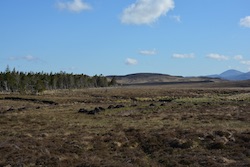
|
Bogs (muskegs) are vital components of the northern landscape, characterizing the boreal forest ecosystem. Such wetlands are formed when permafrost, clay, or bedrock block water drainage, creating a permanent, saturated area. Saturated with water and dominated by sphagnum mosses, these peatlands act as significant carbon sinks, playing a crucial role in global carbon storage. Peat itself is mostly organic material in various states of decomposition. Bogs are highly acidic, and nutrient-poor, and thus, are poor nurseries for most trees, although stunted trees such as willow and black spruce can grow. Bogs, however, support other organisms such as waterfowl, beavers, and mammals.
Fens are similar to bogs but are less acidic and nourished by groundwater rather than rain and melting snow. |
Floodplains
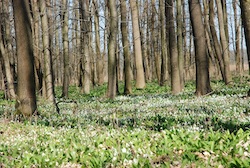
|
Floodplains are dynamic ecosystems woven into the fabric of the boreal forest, tracing the courses of rivers and streams. These expanses periodically inundate, fostering different habitats crucial for the region's biodiversity. Serving as natural corridors, boreal floodplains create vital connections between different ecosystems, facilitating the movement of wildlife. Rich in nutrients, they support diverse vegetation and provide breeding grounds for various species of fish and amphibians. Boreal floodplains are not only a cradle for life but also act as resilient buffers against climate impacts, exemplifying the intricate interplay between water, land, and the flourishing ecosystems in the expansive northern forests. |
Swamps
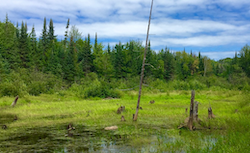
|
Boreal swamps are areas of standing water with trees or shrubs. These swamps provide habitat for various waterfowl and amphibians and are often transitional areas between upland forests and other wetlands, or, shorelines of lakes and streams.The Boreal Forest supports two types of swamp: treed and shrub. As their names suggest, treed swamps are dominated by tall trees such as conifers or hardwood trees, while shrub swamps are dominated by tall shrubs such as willows and alders. |
Marshes
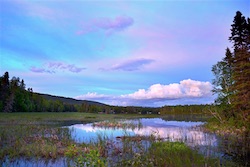
|
Much less common than bogs or swamps, marshes are nonetheless vital wetlands within the greater boreal forest ecosystem. These wetlands are often found in the transitional zone between open wetlands and shorelines. Water levels in boreal marshes fluctuate and are dependent on precipitation, run-off, groundwater, and stream inflow. Marshes are the most biologically diverse wetland in the boreal forests and provide habitats for waterfowl, moose, beavers, muskrats, owls, and many others. There are two types of marshes in the boreal forest: emergent marshes and meadow marshes. Emergent marshes are dominated by cattails and rushes in deeper water while meadow marshes are dominanted by grasses and sedges in shallow water. |
Lakes
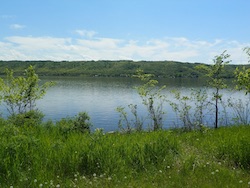
|
Lakes in the Taiga Belt are generally large, permanent bodies of water. They can be shallow or deep, but both are deep enough to prevent marsh vegetation from existing. Shallow lakes are classified as those with an average depth of two meters or less, whereas deep lakes have an average depth of over two meters. When water levels are low on shallow lakes, mudflats can form. Shallow lakes also are chatacterized by surface vegetation. Deep lakes are chracterized by floating and submerged vegetation (such as lily pads). Both shallow and deep lakes provide crucial habitat for numerous forms of wildlife such as beavers, fish, muskrats, waterfowl such as the iconic common loon, shorebirds, birds of prey, and mammals such as moose. |




